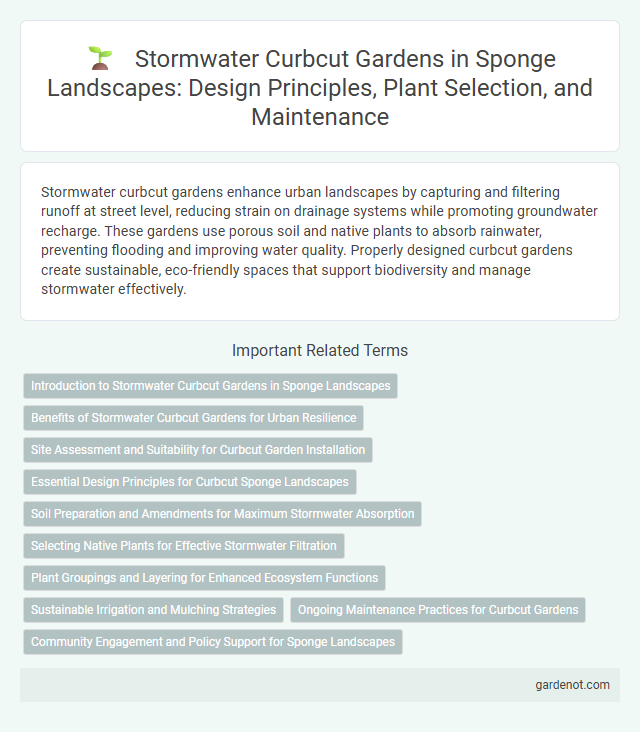Stormwater curbcut gardens enhance urban landscapes by capturing and filtering runoff at street level, reducing strain on drainage systems while promoting groundwater recharge. These gardens use porous soil and native plants to absorb rainwater, preventing flooding and improving water quality. Properly designed curbcut gardens create sustainable, eco-friendly spaces that support biodiversity and manage stormwater effectively.
Introduction to Stormwater Curbcut Gardens in Sponge Landscapes
Stormwater curbcut gardens are engineered depressions designed to capture and infiltrate runoff from streets, reducing urban flooding and improving water quality. These gardens utilize native plants and permeable soils to slow, filter, and absorb stormwater, effectively mimicking natural hydrological processes in sponge landscapes. Integrating stormwater curbcut gardens enhances groundwater recharge and mitigates the environmental impacts of impervious urban surfaces.
Benefits of Stormwater Curbcut Gardens for Urban Resilience
Stormwater curbcut gardens enhance urban resilience by effectively managing runoff through permeable soil and native vegetation, reducing flood risk and improving water quality. These gardens mitigate the urban heat island effect by increasing green space and promoting evapotranspiration. Integrating stormwater curbcut gardens supports biodiversity, improves air quality, and enhances community well-being in dense urban environments.
Site Assessment and Suitability for Curbcut Garden Installation
Site assessment for stormwater curbcut garden installation involves evaluating soil permeability, existing drainage patterns, and slope to ensure optimal water infiltration and prevent erosion. Suitable sites typically exhibit moderate to high rainfall, adequate sunlight, and minimal compacted soils for effective stormwater capture and plant growth. Identifying potential conflicts with underground utilities and pedestrian pathways is critical to maximize garden functionality and maintain urban infrastructure integrity.
Essential Design Principles for Curbcut Sponge Landscapes
Stormwater curbcut gardens optimize urban water management by directing runoff into permeable planting areas, promoting infiltration and reducing flooding. Essential design principles include proper grading to ensure effective water capture, selection of native, drought-tolerant vegetation to enhance filtration, and integration of engineered soil media that supports both plant growth and water absorption. Incorporating overflow outlets and maintenance access further ensures long-term functionality and resilience of curbcut sponge landscapes.
Soil Preparation and Amendments for Maximum Stormwater Absorption
Soil preparation for a stormwater curbcut garden involves deep tilling to enhance infiltration and aeration, often to a depth of 12-18 inches. Incorporating organic amendments such as compost or biochar increases soil porosity and water-holding capacity, promoting maximum stormwater absorption. Utilizing well-drained, sandy loam soils combined with tailored nutrient adjustments supports plant health and optimizes runoff capture efficiency.
Selecting Native Plants for Effective Stormwater Filtration
Choosing native plants like sedges, rushes, and wildflowers enhances stormwater curbcut gardens by promoting efficient filtration and water absorption. These species have deep root systems that improve soil permeability and support microbial activity essential for breaking down pollutants. Incorporating drought-tolerant and flood-resistant natives further stabilizes the landscape while reducing maintenance requirements.
Plant Groupings and Layering for Enhanced Ecosystem Functions
Stormwater curbcut gardens use diverse plant groupings and layered vegetation to optimize water absorption, pollutant filtration, and habitat provision. Native grasses, sedges, and perennials are strategically arranged in vertical layers, from deep-rooted species to surface-covering ground covers, enhancing soil stability and microbial activity. This multilayered planting structure maximizes ecosystem functions such as nutrient cycling, urban heat reduction, and biodiversity support in sponge landscapes.
Sustainable Irrigation and Mulching Strategies
Stormwater curbcut gardens employ sustainable irrigation techniques such as drip systems and rainwater harvesting to maximize water efficiency and reduce runoff. Mulching with organic materials like wood chips or compost enhances soil moisture retention, suppresses weeds, and improves soil health. These combined strategies support resilient urban landscapes by promoting groundwater recharge and minimizing water waste.
Ongoing Maintenance Practices for Curbcut Gardens
Regular inspection of stormwater curbcut gardens ensures optimal water infiltration and prevents clogging from debris and sediment buildup. Routine removal of invasive vegetation and periodic replacement of mulch maintain soil health and plant vitality. Seasonal adjustments, such as pruning and fertilizing, support sustained pollutant filtration and ecosystem function.
Community Engagement and Policy Support for Sponge Landscapes
Stormwater curbcut gardens play a critical role in community engagement by transforming urban spaces into functional green infrastructure that encourages local participation and environmental stewardship. Effective policy support, including incentives and regulations, enhances the adoption and maintenance of sponge landscapes, ensuring stormwater management aligns with sustainability goals. Collaborative efforts between municipalities, residents, and environmental organizations drive the successful implementation of curbcut gardens, promoting resilience against urban flooding.
Stormwater curbcut garden Infographic

 gardenot.com
gardenot.com